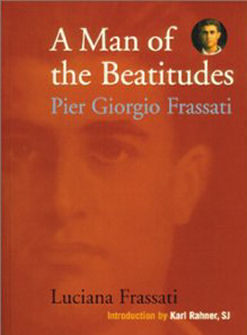Posted April 15, 2010
Book: Pier Giorgio Frassati: Letters to his friends and family
Translated by: Fr. Timothy E. Deeter
Society of St. Paul. Staten Island, NY. 2009. Pp. 258
An Excerpt from the Jacket:
“So what did he do to become a saint? What miracles did he work?” These questions one often hears about the life of Pier Giorgio Frassati. For Catholics who associate sainthood with miracles and spiritual phenomena, the story of a young man who lived an ordinary life seems rather . . .well ordinary. And at first glance, that is what it was: days that revolved around a routine of home, school and friends; weekends spent skiing in the mountains or swimming at the beach. Many of Pier Giorgio’s letters and postcards are filled with the humdrum recitation of details concerning exams taken, tourist sites visited, trans missed, and even greetings to the family pets. His was a life like millions of others, even like ours: it was very ordinary. Or was it? From the first letter written to his father at the age of five, to the last reminder to a friend scrawled with a paralyzed hand as he lay on his deathbed at the age of twenty-four, Pier Giorgio’s strong faith shines forth brightly. The child’s promise that “I’ll pray to Baby Jesus for you” grows throughout the years into a crescendo of blessings and spiritual encouragements until it reaches a shout of “Long live Christ the King!” in manhood. Frequent references to St. Paul, St. Augustine, St. Thomas Aquinas and St. Catherine of Siena intermingle wit his own thoughts about peace, prayer, friendship, charity, family life on earth and life with God forever in Heaven. His personal mission to the poor and the sick is also revealed in his letters, as is his fervent love of country and his hatred for tyranny and injustice. Pier Giorgio was a prophet, and more than that: he was a saint. And in these letters, he shows us that it is possible for us to become saints, too.
An Excerpt from the Book:
Pier Giorgio was at the forefront of political and religious events. If physical violence erupted, he tried to being the voice of reason to the situation. When this failed, he was never afraid to break up groups that interfered with processions or to protect a priest from being pushed around by royal guards during a demonstration. He quietly entered a factory yard to speak to workers seething with Bolshevik anger, spoke up forcefully during arguments with fascists in the classroom or in group meetings, and chased down anti-cleric types who were vandalizing posters for Catholic events.
He fervently encouraged his generation to be loyal to the Pope, but also led them in passionate loyalty to the nation, fighting for justice at a time of political upheaval.
His way of understanding religious commitment and the role of the laity anticipated Vatican Council II by forty years. In discussing the heroic virtues in 1987, the Congregation for the Causes of Saints stated, “We are not accustomed to that kind of sanctity . . .Pier Giorgio Frassati opens new perspectives for understanding the concept of sanctity as it is lived by the laity in a lay environment, dealing with issues that teachers of spirituality would do well to reflect upon.”
Pier Giorgio’s World:
Church and State in early 20th century Italy
Table of Contents:1906-1925
|
|
|

